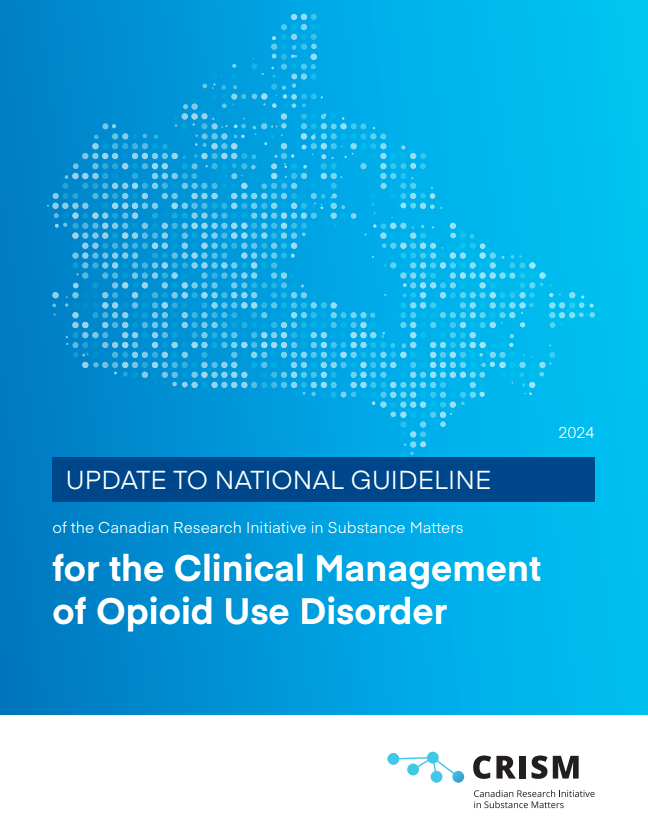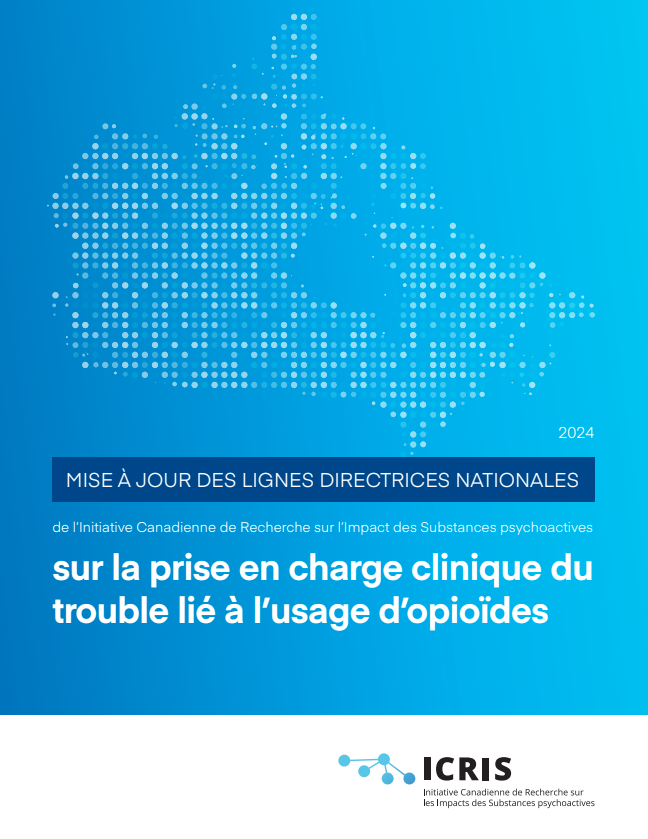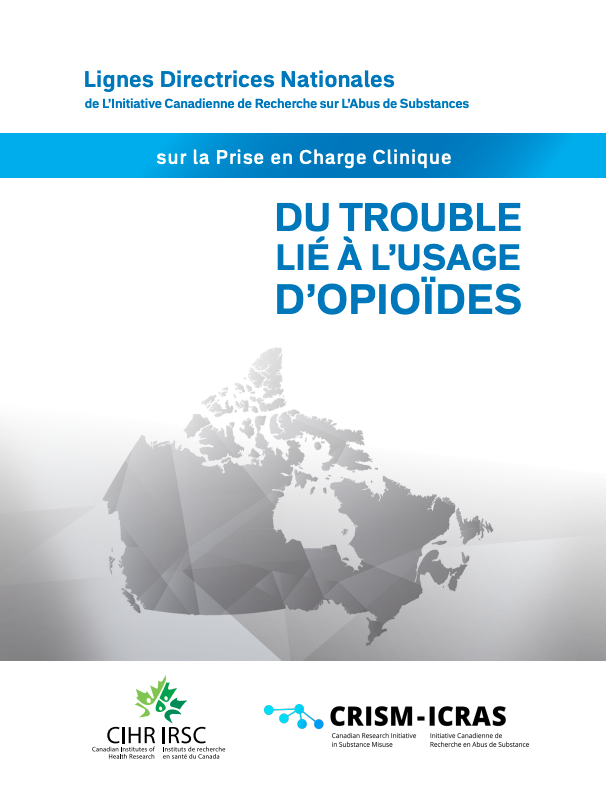National Opioid Use Disorder Guideline
November 2024
National Clinical Guidelines
This guideline is intended for use by health care providers, including physicians, nurse practitioners, pharmacists, clinical psychologists, social workers, medical educators, and clinical care case managers with or without specialized experience in addiction treatment.

In March 2018, North America was facing a rising opioid-related death crisis initially driven by greater availability and use of prescription opioids, followed by a change in the drug market with the introduction of illicitly manufactured fentanyl. This posed a significant threat to public health. In response, CRISM published the first Canadian national clinical practice guideline to assist clinicians in making informed decisions regarding the clinical management of opioid use disorder (OUD).
Recommendations were made in light of existing evidence on prioritizing available treatments and support for people with OUD. Over the past six years, additional measures have been implemented to help reduce the epidemic. In May 2018, the Government of Canada made a significant advancement in improving accessibility to treatment options by lifting restrictions on methadone prescriptions. As a result, subsection 561 class exemptions of the Controlled Drugs and Substances Act (CDSA) are no longer required to prescribe, administer or provide methadone, allowing better access to OUD treatment options.
The COVID-19 pandemic from March 2020 then marked an increase in opioid-related harms nationwide as access to essential services and support was restricted during that time, and the drug supply became increasingly toxic and volatile. According to data from the Public Health Agency of Canada (PHAC) and various authorities across the country, opioid-related harms and deaths significantly rose, and the number of fatalities has continued to exceed pre-pandemic levels ever since. To address these synergistic epidemics, additional measures and efforts, such as the expansion of telehealth services, five have been implemented to alleviate barriers and ensure continuous access to treatment and care for people with OUD.
In an ever-changing landscape of practices and policies, particularly following the COVID-19 pandemic, reviewing and incorporating the latest scientific and clinical evidence is crucial to ensuring optimal clinical management for individuals with OUD. As such, the current CRISM National Guideline for the Clinical Management of Opioid Use Disorder needs to be continuously updated to provide Canadian health care professionals with timely, comprehensive information and evidence-based recommendations on the most effective practices for the treatment of OUD.
In alignment with the Canadian government’s objectives and CRISM’s mission, the following are the 2024 updated national clinical recommendations. This practice guidance updates the 2018 version and incorporates peer-reviewed research published between January 2017 and August 2023. Clinical insights and values of persons with lived, and living experience (PWLLE) were also considered when developing these guidelines. This document aims to build consensus and support efforts to achieve the highest national standards of care for the clinical management of OUD.
Opioid Agonist Therapies
RECOMMENDATION 1 (UPDATED): Buprenorphine and methadone should both be considered as standard first-line treatment options for opioid agonist therapy (STRONG, HIGH)
- For people who initiate opioid agonist therapy with buprenorphine, clinicians should be aware of the higher risk of attrition after the first month of initiation and offer alternative opioid agonist medications in these circumstances (high certainty of evidence).
- When considering methadone, clinicians should be aware of the higher risk of mortality during the first month compared to the remainder of the treatment period (moderate certainty of evidence).
RECOMMENDATION 2 (UPDATED): Opioid agonist therapy with slow-release oral morphine should be available and offered as a second-line treatment option. (MODERATE, STRONG)
Withdrawal Management Strategies
RECOMMENDATION 3 (NO CHANGE): Patients with opioid use disorder should not be offered withdrawal management alone because of the increased rates of relapse, morbidity, and mortality. Concurrent long-term addiction treatment is recommended. (MODERATE, STRONG)
RECOMMENDATION 4 (NO CHANGE): When withdrawal management alone is pursued, a supervised slow opioid agonist taper (depending on the patient) should be provided, with close follow-up, and opioid agonist therapy should immediately be offered if the risk of relapse emerges. (MODERATE, STRONG)
RECOMMENDATION 5 (NO CHANGE): For patients with a successful and sustained response to opioid agonist therapy who wish to discontinue opioid agonist therapy (i.e., medication cessation), clinicians should consider a slow taper approach (depending on the patient). Ongoing addiction care should be considered upon cessation of opioid use. (MODERATE, STRONG)
Psychosocial and Harm Reduction Interventions
RECOMMENDATION 6 (UPDATED): Psychosocial treatments, interventions, and supports can be offered as adjunct treatments to opioid agonist therapy to increase treatment retention.(MODERATE, STRONG)
RECOMMENDATION 7 (UPDATED): Psychosocial treatment should not be a mandatory component of standard treatment for opioid use disorder and should not prevent access to opioid agonist therapy. (MODERATE, STRONG)
RECOMMENDATION 8 (UPDATED): Harm reduction strategies should be offered as part of the continuum of care for patients with opioid use disorder. (MODERATE, STRONG)
Current evidence supports the use of the following harm reduction programs: provision of sterile consumption equipment, overdose prevention education, and access to take-home naloxone kits.
Special Considerations (NEW)
Alternative options: For patients who decline or are not on standard treatments for opioid use disorder and have withdrawn from opioids, oral naltrexone could be discussed as an adjunct pharmacological option.
Special populations: Pregnant people with opioid use disorder who are not in treatment should be encouraged to start a first-line treatment as soon as possible during pregnancy.
CMAJ
A synopsis of the Guideline was published in the Canadian Medical Association Journal (November 12, 2024).




